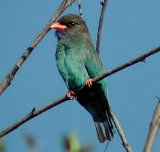
Dollarbird
Encyclopedia
The Oriental Dollarbird (Eurystomus orientalis), also known as the Dollar Roller, is a bird of the roller
family, so named because of the distinctive blue coin-shaped spots on its wings.
It has a length of up to 30 cm, and can be found in east Asia
from northern Australia
to the Japan
archipelago. The bird is an insectivore with a love of beetles and often catches prey whilst flying. The young birds have a darker beak which becomes more orange as it becomes mature.
It is most commonly seen as a single bird with a distinctive upright silhouette on a bare branch high in a tree, from which it hawks
for insects, returning to the same perch after a few seconds.
Roller
The rollers are an Old World family, Coraciidae, of near passerine birds. The group gets its name from the aerial acrobatics some of these birds perform during courtship or territorial flights. Rollers resemble crows in size and build, and share the colourful appearance of kingfishers and...
family, so named because of the distinctive blue coin-shaped spots on its wings.
It has a length of up to 30 cm, and can be found in east Asia
Asia
Asia is the world's largest and most populous continent, located primarily in the eastern and northern hemispheres. It covers 8.7% of the Earth's total surface area and with approximately 3.879 billion people, it hosts 60% of the world's current human population...
from northern Australia
Australia
Australia , officially the Commonwealth of Australia, is a country in the Southern Hemisphere comprising the mainland of the Australian continent, the island of Tasmania, and numerous smaller islands in the Indian and Pacific Oceans. It is the world's sixth-largest country by total area...
to the Japan
Japan
Japan is an island nation in East Asia. Located in the Pacific Ocean, it lies to the east of the Sea of Japan, China, North Korea, South Korea and Russia, stretching from the Sea of Okhotsk in the north to the East China Sea and Taiwan in the south...
archipelago. The bird is an insectivore with a love of beetles and often catches prey whilst flying. The young birds have a darker beak which becomes more orange as it becomes mature.
It is most commonly seen as a single bird with a distinctive upright silhouette on a bare branch high in a tree, from which it hawks
Hawking (birds)
Hawking is a feeding strategy in birds involving catching flying insects in the air. The term usually refers to a technique of sallying out from a perch to snatch an insect and then returning to the same or a different perch...
for insects, returning to the same perch after a few seconds.

